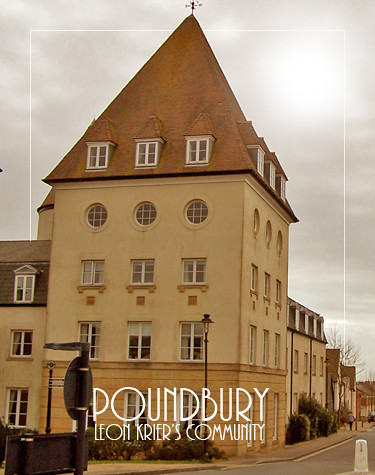
Volume XVIII, Issue VIIId: Leon Krier's 'City of Tomorrow'
Building on the Past
Poundbury, Leon Krier's Future City
Poundbury is based on some of the timeless principles that have enabled many places around Britain to endure and thrive over the centuries. It is a high density urban quarter of Dorchester which gives priority to people, rather than cars, and where commercial buildings are mixed with residential areas, shops and leisure facilities to create a walkable community. The result is an attractive and pleasing place, in keeping with the character of Dorchester, in which people live, work, shop and play. Commissioned by the Prince of Wales and designed by Leon Krier, Poundbury offers a vision for the future returning to a more human scale in its design. Therefore, Poundbury, in its mission, overcomes the ‘Tomorrowland Problem’ by specifying an architecture that transcends a small contemporary period. In many ways it creates a timeless place for its inhabitants. Even more important, the people love it.
An economic assessment completed by Dorset County Council has concluded that the Poundbury development has already contributed over £330million in demand for goods and services to the local economy and will contribute a further £500million by 2025. Poundbury is an urban extension to the Dorset county town of Dorchester, built on Duchy of Cornwall land, according to timeless principles of architecture and urban planning as advocated by HRH The Prince of Wales. It is currently home to 1,500 people in different types of housing, including social housing, as well as providing employment for some 1,000 people. The report estimates that the construction activity that has taken place in Poundbury since 1994, when the development began, has created the equivalent of 1,877 person-years in employment and 1,049 business-years of work for firms including the self-employed. These figures will grow over the next 15 years as the development is completed. The assessment indicates that when Poundbury is completed it will be supporting over 430 new full-time equivalent jobs and 121 new businesses in the local area on a long-term basis. This means a contribution of around £40million per annum in increased demand for local goods and services and a net equivalent of about £20million per annum added to the local economy.
Simon Conibear, Poundbury Development Manager said: “We have always been aware that Poundbury has been a major source of employment and economic activity, for Dorchester particularly, but it is interesting to have this quantified. The important thing is the legacy we leave, and it is encouraging that even after construction activity ceases in 15 years time, there will be a continuing major economic benefit to the Dorset sub-region.”Anne Gray of Dorset County Council said: “Poundbury has already had a positive economic impact and there is more to come. A long-lived project such as this is really important to the area both throughout the construction phase and in terms of the permanent impacts which will be felt in the sub-region.”
Over the course of the development, Poundbury is expected to increase the population of Dorchester by about one-quarter, by approximately 5,000 people. By early 2010, there were 931 completed dwellings, with more than 25 per cent social housing, and a population of around 1,820 . More than 1,100 people were employed in businesses located at Poundbury. Poundbury is now more than a third built with plans for 2,466 homes by 2025. Poundbury has proved increasingly influential, attracting international interest and generating hundreds of organised tours every year from architects, town planners and others. The success of Poundbury has now been recognised far beyond Dorset and many of the principles have been incorporated into the Government’s Planning Guidance Note (PPG3). Poundbury was also highlighted as an exemplar in “Living Working Countryside. The Taylor Review of Rural Economy and Affordable Housing” a report by Matthew Taylor MP, published in July 2008 and commissioned by the Government.
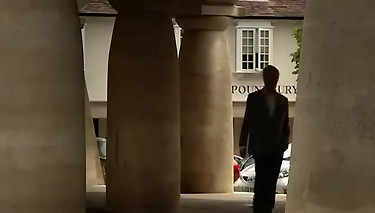
Human-scaled Poundbury.

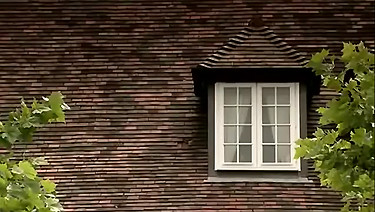
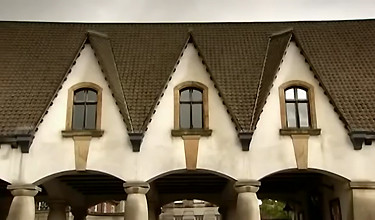
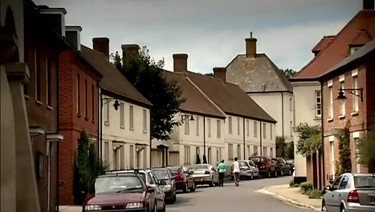

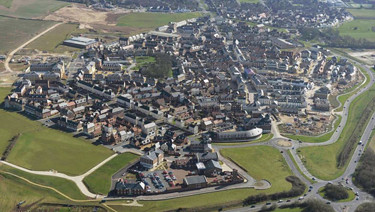
A Royal Revolution
Is Prince Charles’s Poundbury Vision Having Last Laugh
[click to read]
In a room of raw concrete block walls and exposed steel beams, a man with a long hipster beard takes an order on his iPad and froths up a flat white. Young mums and retired couples sit at long communal tables among Wi-Fi workers. It could be a trendy east London cafe in a repurposed industrial space, but this is the centre of Poundbury, the Prince of Wales’s traditionalist model village in Dorset. And there’s not a doily or tweed jacket in sight. (read more)
Everyday Life in Modern Coruscant
Asian Megacities as Political Theater
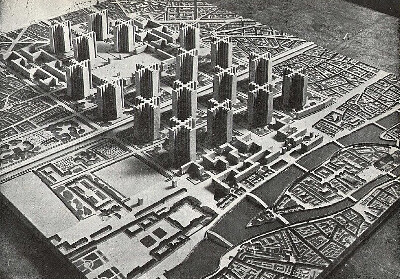
What Le Corbusier would have wrought in Paris has become the new reality of Bejing and Shanghai.
Le Corbusier once wrote of his Plan Voisin for Paris: “Since 1922 [for the past 42 years] I have continued to work, in general and in detail, on the problem of Paris. Everything has been made public. The City Council has never contacted me. It calls me ‘Barbarian’!” -- Le Corbusier’s writings, p. 207.
Fast forward to the Twenty-first Century and Shanghai [Le Corbusier on steroids]. It all seems like the realization of the fictional Coruscant from Star Wars... a completely urban environment that stretches as far as the eye can see. The entire planet of Coruscant is one continual city.
Guy Sorman discusses the rise of Asian 'Super Megagopolises' [click to read] in City Journal. Looking at the Mega-model of Shanghai, one could begin to wonder: "can Coruscant be that far off." Sorman points out, however, that Shanghai is largely a political creation...designed to create the impression that China is ready for business with the world. [1.]
Every day the city teems with life and every night the workers necessary to make it function vacate the pristine city. It is like Disney World, where the 'cast members' descend into 'Utilidor,' remove their costumes, and disappear to homes elsewhere.
For Shanghai workers, 'homes elsewhere' often means crowded and substandard. Just as China's factories are seldom seen by Westerners, those who maintain the stage for world commerce live in a vastly different world than the one they 'portray' in their 'day jobs.'
Or perhaps, the Death Star in Star Wars is a better analogy. Its scale is way beyond human. It is intended to convey a sense of awe. Might we be looking at the work of some latter day Nimrod, seeking to elevate himself to the heavens?
Sorman points out how the mad rush into the 21st Century has obliterated the traditional spaces of Shanghai and Beijing, which were much more human in size and scate. Again Star Wars comes to mind. Green beautiful planets like Naboo and Alderon risk elimination as the Empire expands its grasp.
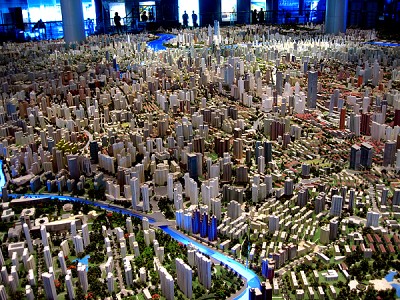
This scale model of Shanghai dwarfs the people in the room...

...and calls to mind the fictional city of Coruscant.
In the 'Sixties America sought to 'remake' her major cities. Le Corbusier style housing blocks were constructed to elevate the urban poor. Many of these 'projects' have since been torn down. While we were building them Moscow was building similar blocks of apartments. Today in Moscow, urban youths flock to the rooftops. [2.] Called 'Roofers,' these young people seek the rooftops simply for the openness and the view.
How to Return to the Village
Returning Government to the People in the 'Audience'
Nineteenth Century America was a nation of villages. Great centers of commerce existed, but they were fed by a vibrant countryside. When Thomas Jefferson created his ideal 'Academic Village' to house the University of Virginia he purposefully left one side open to the surrounding agricultural land. From the steps of the Rotunda one could look upon the rolling hills of Albemarle County.
Architect Stanford White convinced the University to fill the void with Old Cabell Hall a long time ago. The recently completed South Lawn attempts to recreate a space leading off into the trees of Charlottesville. The challenge of getting back to the garden is ever before us. Rooftop Gardens [click to read] offer one method of getting people and open spaces together. Reclaiming existing environments is another. Aging strip malls could be recycled into village centers for the surrounding suburban homes, offering a place residents could walk or bicycle to. Vacant lots and neglected riverfronts can become parks and gardens.

Proposed Renewal of the Crozet Shopping Center.
Drawing created by the Kirchman Studio.
Suburb bashing has always been a fashionable intellectual pastime.That is one reason I like Robert A. M. Stern. He sees the reasons people seek out single family dwellings of a traditional form. I have a friend who lives on the upper West side and his penthouse with a view of the Hudson is very nice but give me my gardens.People put up with the wretched infrastructure overload and strip centers because the village is still appealing. The residential areas become landscaped oasis for their residents. Kids play outside the house in view of the kitchen window. People visit at the back fence. Moreover the suburbs are seen by their dwellers as affirming opportunity and safety. If people had no emotion for their homes they would be fine with Le Courbusier type high rises but that is simply not the case.The problem is really one of infrastructure and public space [or lack therof]. Strip malls and box stores create a sterile wasteland but they may become the village centers of the future.
Time magazine once featured a piece called 'Repurposing Suburbs' which shows some fine examples of recreating this type of public space. This Crozet project turns a tired strip mall into a village center. One cannot wait for Crozet's redesigner to get his creative hands on some of the new "Town Center" projects which are now just collections of big box stores. Some time ago I drew a concept where the CSX tracks between Staunton and Charlottesville became a light rail line connecting Staunton, Fishersville, Waynesboro, Crozet, Ivy, The University of Virginia Medical Center and Downtown Charlottesville. The result would be a series of village centers and a better utilization of existing infrastructure.
City Journal's writers draw conflicting conclusions. Houston is touted as encouraging its middle class while Gotham offers limited options. Dense urban areas do tend to create energy efficiency. The trick is to see opportunities to improve the communities we have already created.That would certainly involve offering condominiums and a pedestrian friendly center to suburban communities and reclaiming all those wonderful old low density neighborhoods of our cities.
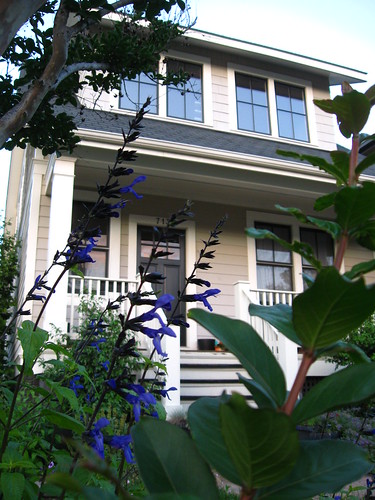
Front Yard garden, Arlington, Virginia. Photo by Bob Kirchman.

Front Porch, Arlington, Virginia. Photo by Bob Kirchman.

Workers paint the Ebenezer Presbyterian Church in Rockbridge County, Virginia. Photo by Bob Kirchman.
[Click to Read]
